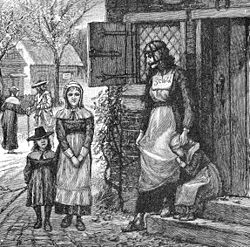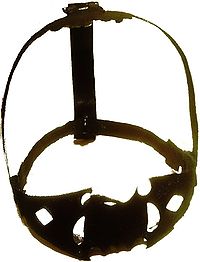
Scold's bridle
Encyclopedia


England, Wales and Scotland
First recorded in Scotland in 1567, the branks were also used in England, where it may not have been formally legalized as a punishment. The kirk-sessions and barony courts in Scotland inflicted it upon male or female transgressors or women that were considered to be 'rude', 'naggers' or 'common scoldCommon scold
In the common law of crime in England and Wales, a common scold was a species of public nuisance—a troublesome and angry woman who broke the public peace by habitually arguing and quarreling with her neighbours...
s'. Branking (in Scotland and the North of England) was designed as a mirror punishment
Mirror punishment
A mirror punishment is a penal form of poetic justice which reflects the nature or means of the crime in the means of punishment as a form of retributive justice — the practice of “repaying” a wrongdoer ‘in kind’....
for 'shrews' or "scolds" — women of the lower classes whose speech was "riot
Riot
A riot is a form of civil disorder characterized often by what is thought of as disorganized groups lashing out in a sudden and intense rash of violence against authority, property or people. While individuals may attempt to lead or control a riot, riots are thought to be typically chaotic and...
ous" or "troublesome" — women accused of witchcraft
Witchcraft
Witchcraft, in historical, anthropological, religious, and mythological contexts, is the alleged use of supernatural or magical powers. A witch is a practitioner of witchcraft...
— by preventing such 'gossips or scolds' from speaking; however, it was also used as corporal punishment
Corporal punishment
Corporal punishment is a form of physical punishment that involves the deliberate infliction of pain as retribution for an offence, or for the purpose of disciplining or reforming a wrongdoer, or to deter attitudes or behaviour deemed unacceptable...
for other offenses, notably on female workhouse
Workhouse
In England and Wales a workhouse, colloquially known as a spike, was a place where those unable to support themselves were offered accommodation and employment...
inmates. The person to be punished was placed in a public place for additional humiliation and sometimes beaten.
While the branks are thought of a form of punishmment for females, it should be made clear that from the Burgh Records of Scotland's major towns, the branks were used on both men and women: 'Patrick Pratt sall sit … bound to the croce of this burght, in the brankis lockit' (1591 Aberd. B Rec. II. 71) / 'He shall be put in the branks be the space of xxiiij houres thairafter' (1559 (c 1650) Dundee B. Laws 19. ) /' Iff evir the said Elizabeth salbe fund scolding or railling … scho salbe sett upone the trone in the brankis and be banishit the toun thaireftir' (1653 Lanark B. Rec. 151).
When the branks was placed on the 'gossip
Gossip
Gossip is idle talk or rumour, especially about the personal or private affairs of others, It is one of the oldest and most common means of sharing facts and views, but also has a reputation for the introduction of errors and variations into the information transmitted...
er's' head, they could be led through town to show that they had been doing something wrong or scolding too often. This would also humiliate them into 'repenting' their 'riotous' actions. There was a spike
Spike
Spike may refer to:-Device to puncture or fasten:* Nail , especially one over ten inches long* Rail spike, or Screw spike used to construct railroad tracks* Tree spiking, making a tree dangerous to cut with a chainsaw...
inside the gag
Gag
A gag is usually a device designed to prevent speech, often as a restraint device to stop the subject from calling for help. This is usually done by blocking the mouth, partially or completely, or attempting to prevent the tongue, lips, or jaw from moving in the normal patterns of speech. They are...
that would prevent any talking since any movement of the mouth could lead to a severe piercing of the tongue. When wearing the mask it was impossible for the woman to either speak or eat.
In Scotland, the branks could also be on permanent display, attached to a specific place of note, say the town cross. Then, the ritual humiliation would take place there, with the perpetrator/victim on public show. Having the branks on permanent display, so to speak, may have acted as a reminder to the populace of the consequences of any rash action or slander. Whether the person was paraded or simply taken to the point of punishment, the process of humiliation and potential repentance was the same.
Quaker women were sometimes punished with the branks for preaching their doctrinal message in public places.
Jougs
Jougs
The jougs, juggs, or joggs is an instrument of punishment formerly in use in Scotland, the Netherlands and other countries.- Purpose :...
were similar in their purpose as a pillory
Pillory
The pillory was a device made of a wooden or metal framework erected on a post, with holes for securing the head and hands, formerly used for punishment by public humiliation and often further physical abuse, sometimes lethal...
, however they did not restrain the sufferer from speaking.
It was generally used in both England and Scotland in the 16th and 17th centuries.
The time spent in the bridle was normally allocated as a punishment by a local magistrate.
New World
The scold's bridle did not see much use in the New WorldNew World
The New World is one of the names used for the Western Hemisphere, specifically America and sometimes Oceania . The term originated in the late 15th century, when America had been recently discovered by European explorers, expanding the geographical horizon of the people of the European middle...
, though Olaudah Equiano
Olaudah Equiano
Olaudah Equiano also known as Gustavus Vassa, was a prominent African involved in the British movement towards the abolition of the slave trade. His autobiography depicted the horrors of slavery and helped influence British lawmakers to abolish the slave trade through the Slave Trade Act of 1807...
recorded that it was commonly used to control Virginia slaves in the mid-18th century. Rather, men and women were placed in the stocks
Stocks
Stocks are devices used in the medieval and colonial American times as a form of physical punishment involving public humiliation. The stocks partially immobilized its victims and they were often exposed in a public place such as the site of a market to the scorn of those who passed by...
as an equivalent punishment.
Germany
During 1500s it spread out to some other European countries, including Germany. Some even had a bell on top of them to draw even more attention to the wearer, increasing their humiliation. It was finally used until the early 1800s as a punishment in German workhouses.Historical examples
In 1567 Bessie Tailiefeir slandered Baillie Thomas Hunter in EdinburghEdinburgh
Edinburgh is the capital city of Scotland, the second largest city in Scotland, and the eighth most populous in the United Kingdom. The City of Edinburgh Council governs one of Scotland's 32 local government council areas. The council area includes urban Edinburgh and a rural area...
, saying that he was using false measures. She was sentenced to the brankit and set on the cross for one hour.
2 of the bridles were purchased for use by the Walsall
Walsall
Walsall is a large industrial town in the West Midlands of England. It is located northwest of Birmingham and east of Wolverhampton. Historically a part of Staffordshire, Walsall is a component area of the West Midlands conurbation and part of the Black Country.Walsall is the administrative...
town authorities during the 17th century, but it is not clear what later happened to either of them or even if they were ever used.
In Walton on Thames, in England, a scold's bridle is displayed in the vestry of the church, dated 1633, with the inscription "Chester presents Walton with a bridle, To curb women's tongues that talk too idle." The story is that one Chester
Chester
Chester is a city in Cheshire, England. Lying on the River Dee, close to the border with Wales, it is home to 77,040 inhabitants, and is the largest and most populous settlement of the wider unitary authority area of Cheshire West and Chester, which had a population of 328,100 according to the...
lost a fortune due to a woman's gossip, and presented the town with the instrument of torture out of anger and spite.
As late as 1856 it was in use at Bolton-le-Moors, Lancashire.
Variants
The tongue's curb could be a flat iron plate that prevented the tongue's movement or a spike-studded iron bit that punished its victim rather more painfully. Other variants are shaped like an animal's head, such as a cow for a lazy bonesLazy Bones
Lazy Bones was originally a comic strip in the British comic Whizzer and Chips. It made its first appearance in 1978.The strip was about a boy called Benny Bones, who would constantly fall asleep everywhere, much to the annoyance of his parents. Until 1986 the strip was drawn by Colin Whittock, and...
, a shrew
Shrew
A shrew or shrew mouse is a small molelike mammal classified in the order Soricomorpha. True shrews are also not to be confused with West Indies shrews, treeshrews, otter shrews, or elephant shrews, which belong to different families or orders.Although its external appearance is generally that of...
for a scold, a donkey
Donkey
The donkey or ass, Equus africanus asinus, is a domesticated member of the Equidae or horse family. The wild ancestor of the donkey is the African Wild Ass, E...
for a fool
Foolishness
Foolishness is the lack of wisdom. In this sense it differs from stupidity, which is the lack of intelligence. An act of foolishness is sometimes referred to as a folly....
, a hare
Hare
Hares and jackrabbits are leporids belonging to the genus Lepus. Hares less than one year old are called leverets. Four species commonly known as types of hare are classified outside of Lepus: the hispid hare , and three species known as red rock hares .Hares are very fast-moving...
for an eavesdropper or a pig
Domestic pig
The domestic pig is a domesticated animal that traces its ancestry to the wild boar, and is considered a subspecies of the wild boar or a distinct species in its own right. It is likely the wild boar was domesticated as early as 13,000 BC in the Tigris River basin...
for a glutton
Glutton
Glutton may refer to:* One who over-indulges in and over-consumes food, drink, or intoxicants to the point of waste. See Gluttony* Another name for the wolverine*Glutton , upcoming film...
.
In literature
The Scold's BridleThe Scold's Bridle
The Scold's Bridle is a crime novel by English writer Minette Walters. The book, Walters' third, won a CWA Gold Dagger.-Synopsis:Mathilda Gillespie, an eccentric recluse known for her incredible meanness of nature, is found dead in her bathtub, her wrists slashed and her head locked inside a...
is the title of a novel by Minette Walters
Minette Walters
Minette Walters is an English crime writer.- Life and work :After her birth in Bishop’s Stortford to a serving army officer, Capt Samuel Jebb and his wife Colleen, the first 10 years of Minette’s life were spent moving between army bases in the north and south of England...
, where a scold's bridle is a key element in the plot.

